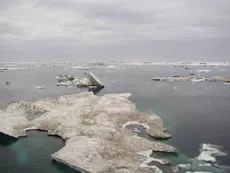Cryosphere glossary
depth of snow
vertical interval between the top surface of a snow layer and the ground beneath; the layer is assumed to be evenly spread over the ground which it covers.
depth of thaw
the minimum distance between the ground surface and frozen ground at any time during the thawing season in an area subject to seasonal freezing and thawing.
depth of zero annual amplitude
the distance from the ground surface downward to the level beneath which there is practically no annual fluctuation in ground temperature.
desiccation crack
crack or fissure developed in fine-grained soil material as a result of shrinkage during drying.
desiccation polygon
closed, multi-sided, patterned ground feature formed by desiccation cracks in fine-grained soil material, usually less than 2 meters (6.6 feet) in diameter.
design depth of frost penetration
(1) (North American usage) the mean of the three largest depths of seasonal frost penetration measured during the past thirty years, or the largest depth of seasonal frost penetration beneath a snow-free soil surface measured during the past ten years (2) (Russian usage) the mean of the depths of seasonal frost penetration measured during at least the last ten years with the ground surface free of snow and the groundwater level below the depth of seasonal frost penetration.
design freezing index
the cumulative number of degree-days below 0 degrees Celsius, calculated by taking the average of the seasonal freezing indices for the three coldest winters in the most recent 30 years of record.
design thawing index
the cumulative number of degree-days above 0 degrees Celsius, calculated by taking the average of the seasonal thawing indices for the three warmest summers in the most recent 30 years of record.
destructive metamorphism
snow metamorphism that rounds the comers and edges of an ice crystal.
detachment failure
a slope failure in which the thawed or thawing portion of the active layer detaches from the underlying frozen material.
dew point
the temperature to which a given parcel of air must be cooled at constant pressure and constant water-vapor content in order for saturation to occur; when this temperature is below 0 degrees Celsius, it is called the frost point.
diamond dust
a type of precipitation composed of slowly falling, very small, unbranched crystals of ice which often seem to float in the air; it may fall from a high cloud or from a cloudless sky, it usually occurs under frosty weather conditions (under very low air temperatures).
dielectric constant
measure of the ability of the soil to store electrical energy in the presence of an electrostatic field.
dilation crack
a tensile fracture in a frozen material due to surface extension caused by doming.
dilation crack ice
ice that forms in dilation cracks.
dip pole
either of the two points on the earth's surface at which magnetic meridians converge; the horizontal component of the magnetic field of the earth becomes zero at this point; also called the magnetic pole.
dipole anomaly
An Arctic atmospheric pressure pattern characterized by high pressure centered over the northern Beaufort Sea and unusually low pressure centered over the Kara Sea. This pattern contributes to ice loss in summer, causing winds to blow ice away from the coast.
dirt cone
a cone-shaped formation of ice that is covered by dirt; a dirt cone is caused by a differential pattern of ablation between the dirt covered surface and bare ice.
dirty ice
ice that contains sediments stirred up and tangled in the ice as it grows.
Image

Terry Whitledge, National Oceanic and Atmospheric Administration/Department of Commerce
discontinuous permafrost
permafrost occurring in some areas beneath the exposed land surface throughout a geographic region where other areas are free of permafrost.